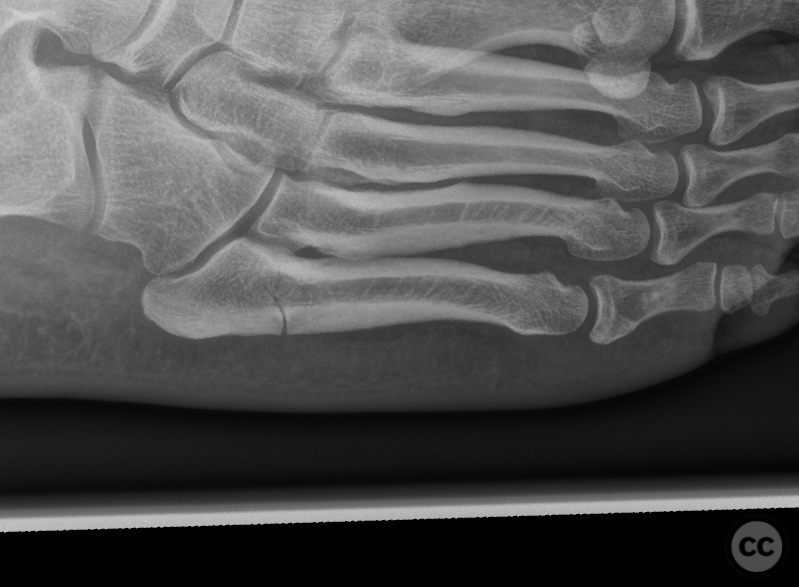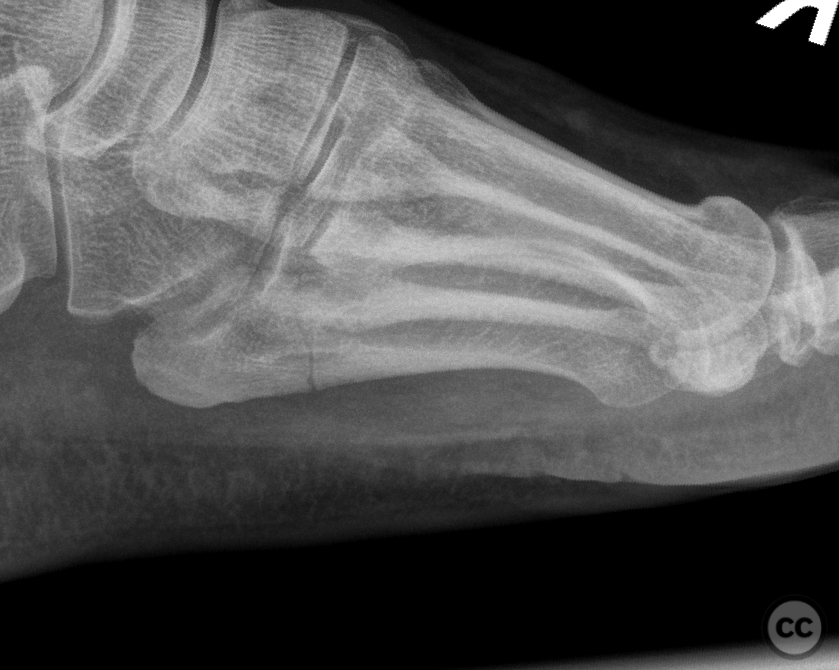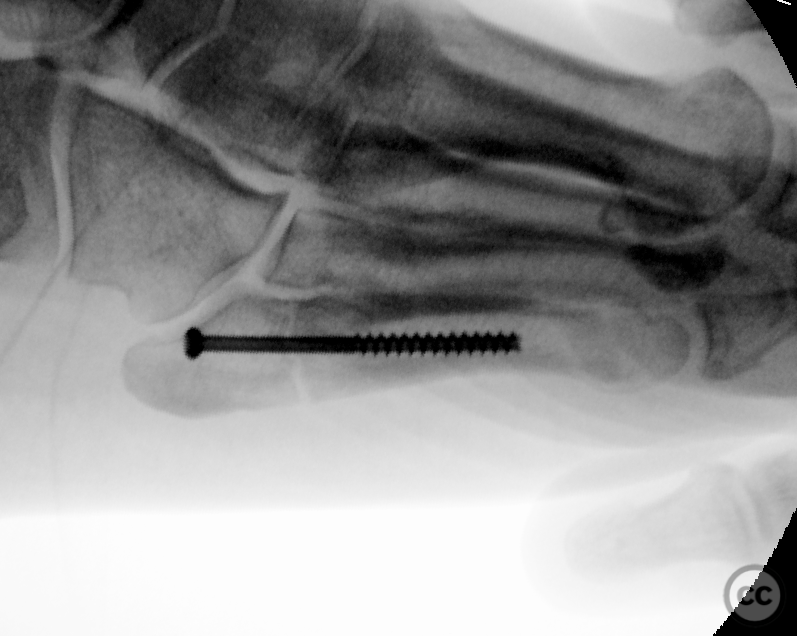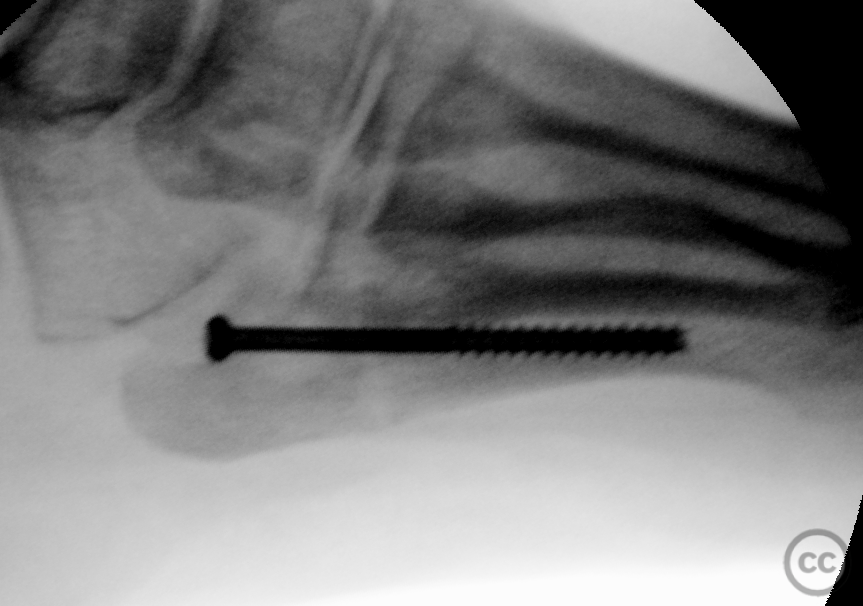Percutaneous strain relief screwfixation of a chronic 5th metatarsal stress fracture
Score and Comment on this Case
Clinical Details
Clinical and radiological findings: A 62-year-old male presented with chronic lateral foot pain persisting for approximately 12 months. The patient had been managing the discomfort without seeking medical attention until recently when a general practitioner ordered an X-ray of the foot. The radiographs revealed a stress fracture in Dameron zone 3 of the fifth metatarsal.
Preoperative Plan
Planning remarks: The preoperative plan included a percutaneous approach for strain relief screw fixation. The trajectory of the screw was planned preoperatively based on the diaphyseal axis to determine the correct entry point.
Surgical Discussion
Patient positioning: The patient was positioned supine on the operating table with the affected foot accessible for fluoroscopic imaging and instrumentation.
Anatomical surgical approach: Under fluoroscopic guidance, a small incision was made at the planned entry point at the apex of the proximal 5th MT
Operative remarks:Intraoperatively, the guidewire placement was precise, and the subsequent drilling and screw insertion were unremarkable. The 4.0 mm cannulated screw engaged well with good compression achieved through tight thread engagement in the diaphysis.
Postoperative protocol: Postoperatively, the patient was placed in an ankle orthosis and advised to adhere to partial weight-bearing for 6 weeks.
Orthopaedic implants used: 4.0 mm cannulated screw
PubMed® Literature Review
Generated by The Literature - Realtime PubMed® AnalysisIntramedullary screw fixation has emerged as a preferred surgical technique for addressing non-unions of the fifth metatarsal [1], with various studies reporting high rates of success when larger diameter screws are used [1][2]. A study utilizing a larger diameter 5.5 mm cannulated variable-pitch compression titanium screw reported radiological union achieved at an average of 7.2 weeks postoperatively with satisfactory functional outcomes [1]. Similarly, another study highlighted that smaller-diameter screws significantly increased the risk of bone union disorder compared to larger ones (odds ratio 4.81) [2].
While intramedullary screw fixation remains popular, alternative methods such as plantar-lateral plating have been explored due to some reports of failures after screw fixation in athletes [6][8]. Plantar-lateral plate fixation was shown to allow more cycles and higher peak loads before failure compared to intramedullary screws when tested under cantilever bending conditions in cadaveric specimens simulating Jones fractures [4].
The timing and protocol for weightbearing following surgery is also crucial since early mobilization can facilitate functional recovery without compromising healing outcomes [5][7]. Studies comparing early weightbearing (EWB) protocols against delayed weightbearing (DWB) did not find significant differences in healing times or rates between both groups; thus EWB may be safe following solid intramedullary screw fixation without increasing risks for delayed unions or nonunions [5].
Despite these findings suggesting that aggressive rehabilitation does not hinder fracture healing or delay bone union timeframes necessary for return-to-play among professional soccer players were observed shortest amongst those treated promptly with surgical stabilization followed by early limb loading post-surgery starting from week two after surgery intervention[10].
Overall consensus suggests that operative treatment leads to better outcomes than conservative management across acute fractures, delayed unions, and non-unions[3][9][11]. For competitive athletes where refracture is a concern after initial treatment with small diameter screws[12], maximizing initial fixation stiffness through appropriate selection of implant size may reduce late failure rate.
In conclusion, strain reduction screw technology applied via an appropriately sized intramedullary device seems beneficial for achieving union in cases of fifth metatarsal non-union. Early weightbearing protocols do not appear detrimental if implemented cautiously post-surgery while considering individual patient factors such as age which might influence healing dynamics.
Search for Related Literature

Dr Ed Oates
- Germany , Schleswig Holstein
- Area of Specialty - General Trauma
- Position - Specialist Consultant

Industry Sponsership
contact us for advertising opportunities




Article viewed 331 times
15 Feb 2024
Add to Bookmarks
Full Citation
Cite this article:
Oates, E.J. (2024). Percutaneous strain relief screwfixation of a chronic 5th metatarsal stress fracture. Journal of Orthopaedic Surgery and Traumatology. Case Report 31607644 Published Online Feb 15 2024.